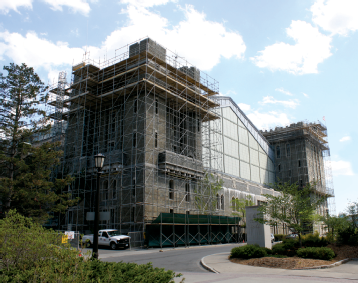An $8 million overhaul for Barton Hall, home to ROTC and so much more
An $8 million overhaul for Barton Hall, home to ROTC and so much more
"No Cornellian needs to be informed about Barton Hall," Morris Bishop 1913, PhD '26, noted in a rundown of campus buildings in A History of Cornell. "With its floor bigger than a football field, it was in its time the largest university drill hall in the country."

Bishop published his history in 1962, and in the intervening half-century the fortresslike edifice has ranged far beyond its original mission as a military training ground. Approaching its centennial—it was completed in 1915, built from Llenroc stone at a cost of some $350,000—Barton boasts a surprisingly diverse fan base. Yes, it has long been the headquarters of ROTC, and it served as an airplane hangar during the First World War (and an armory during the Second). But the building—named after Colonel Frank Barton 1891, Cornell's first ROTC commandant—has played host to the Dalai Lama and the Grateful Dead, not to mention umpteen track meets and reunion luncheons and rained-out commencements. In April 1969, during the turmoil of the Straight Takeover, it housed the three-day teach-in known as the Barton Hall Community. On the establishment side: the Cornell Police offices are in the basement. Until recently Barton was home to the Cornell Savoyards, the Gilbert & Sullivan operetta club that rehearsed atop its south tower, building its sets there and lowering them down the narrow stairs via pulley.

The Savoyards (and other top-floor tenants) got their marching orders as Barton underwent an extensive three-year renovation that necessitated partial removal of the roof. To be completed in early 2011, the $8 million project includes structural repairs, roof and window replacement, gutter work, and masonry restoration to address decades of water damage. "There was very little maintenance done over the life of the building," says Darrell Reynolds '06, a project coordinator for facilities in the contract colleges. "In terms of the roof and masonry, we're hoping this restoration will last fifty-plus years."
In early October, as the project was winding down, a massive crane was brought in to set capstones on the parapet walls of the south tower, as well as reinstall a radio antenna and flagpole. The building has been open during construction, with work halting for major events like reunion. "It's been fun, seeing the progress and bringing Barton back to its natural state," says Reynolds. And, he admits, the job has its fringe benefits. "The view is great," he says. "From the roof, you can see all of Cayuga Lake."


